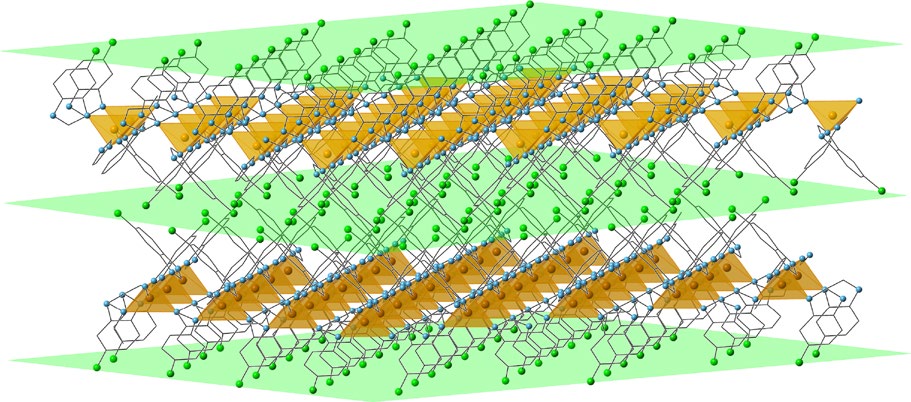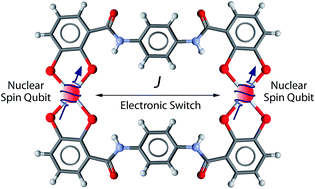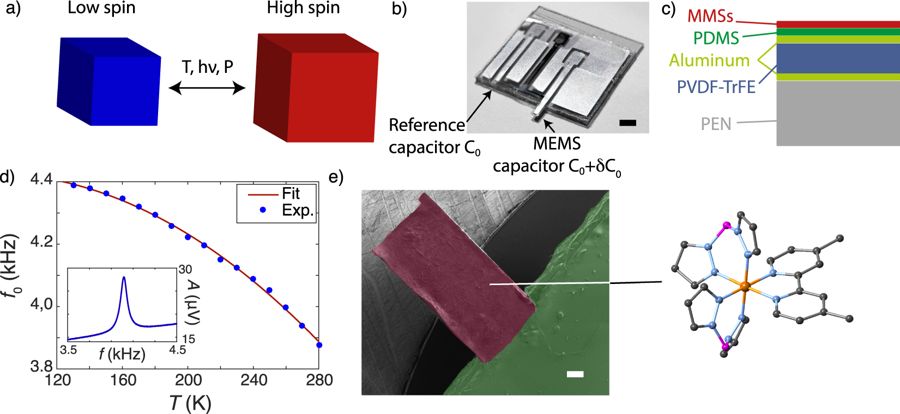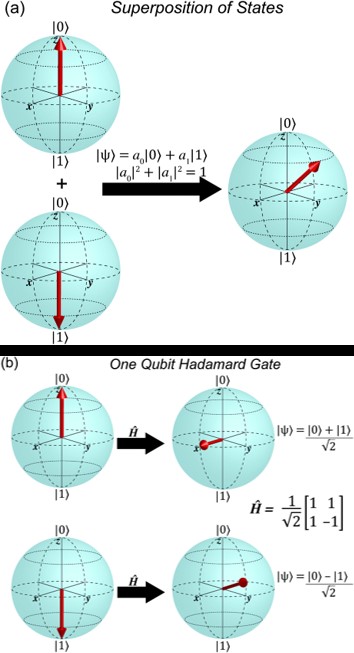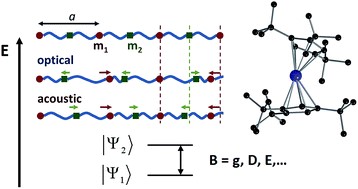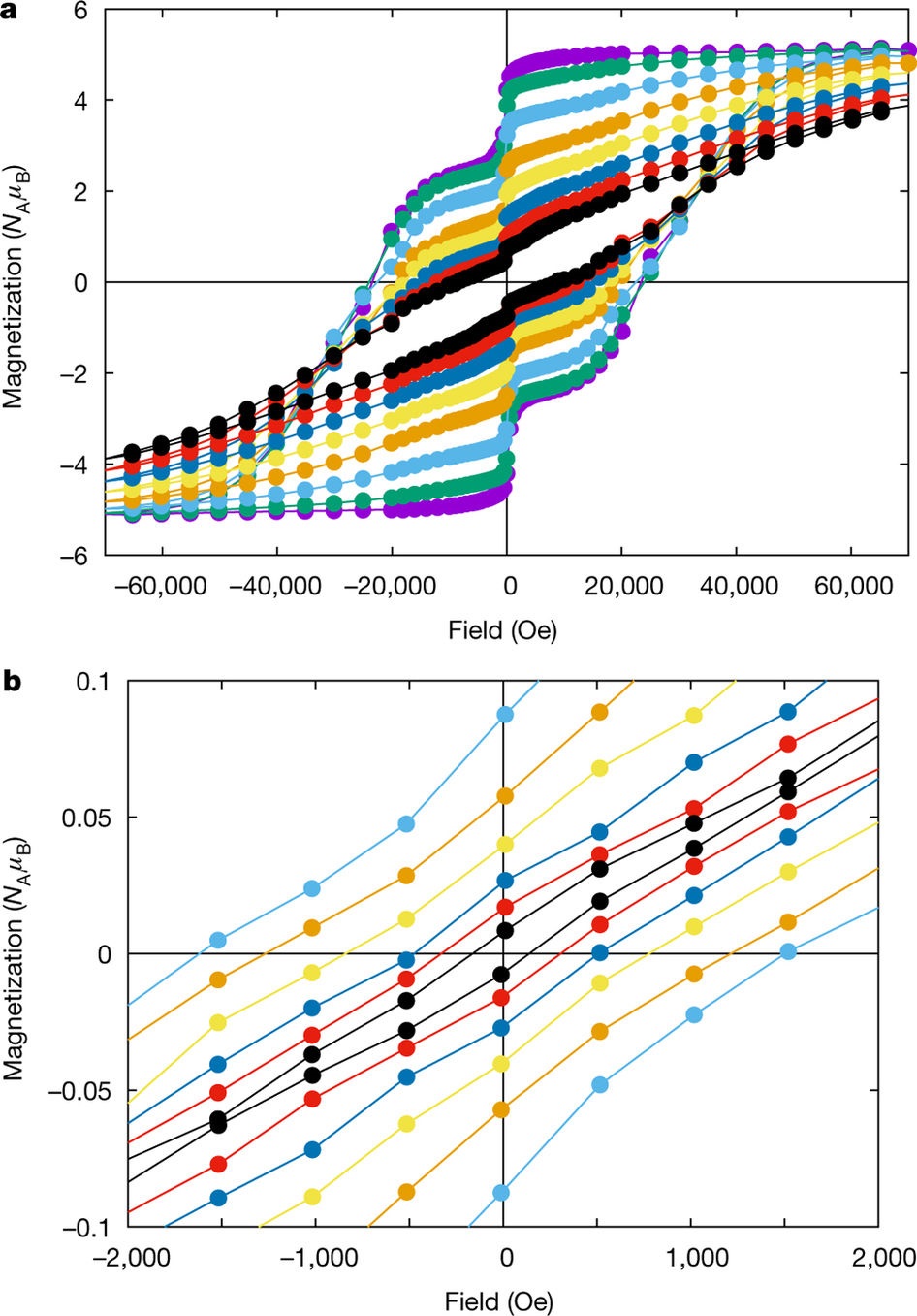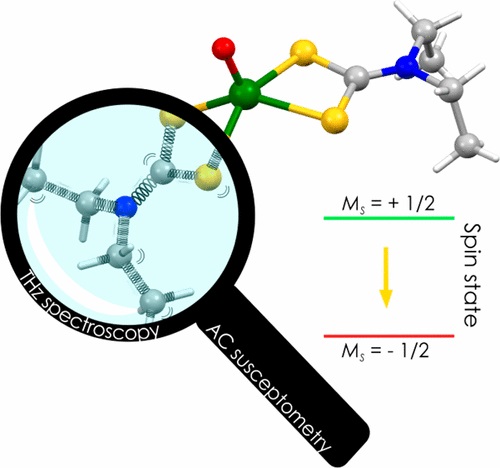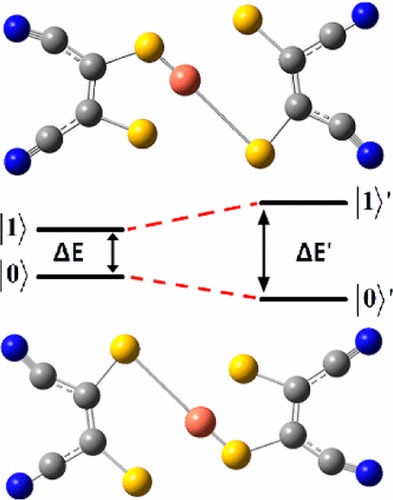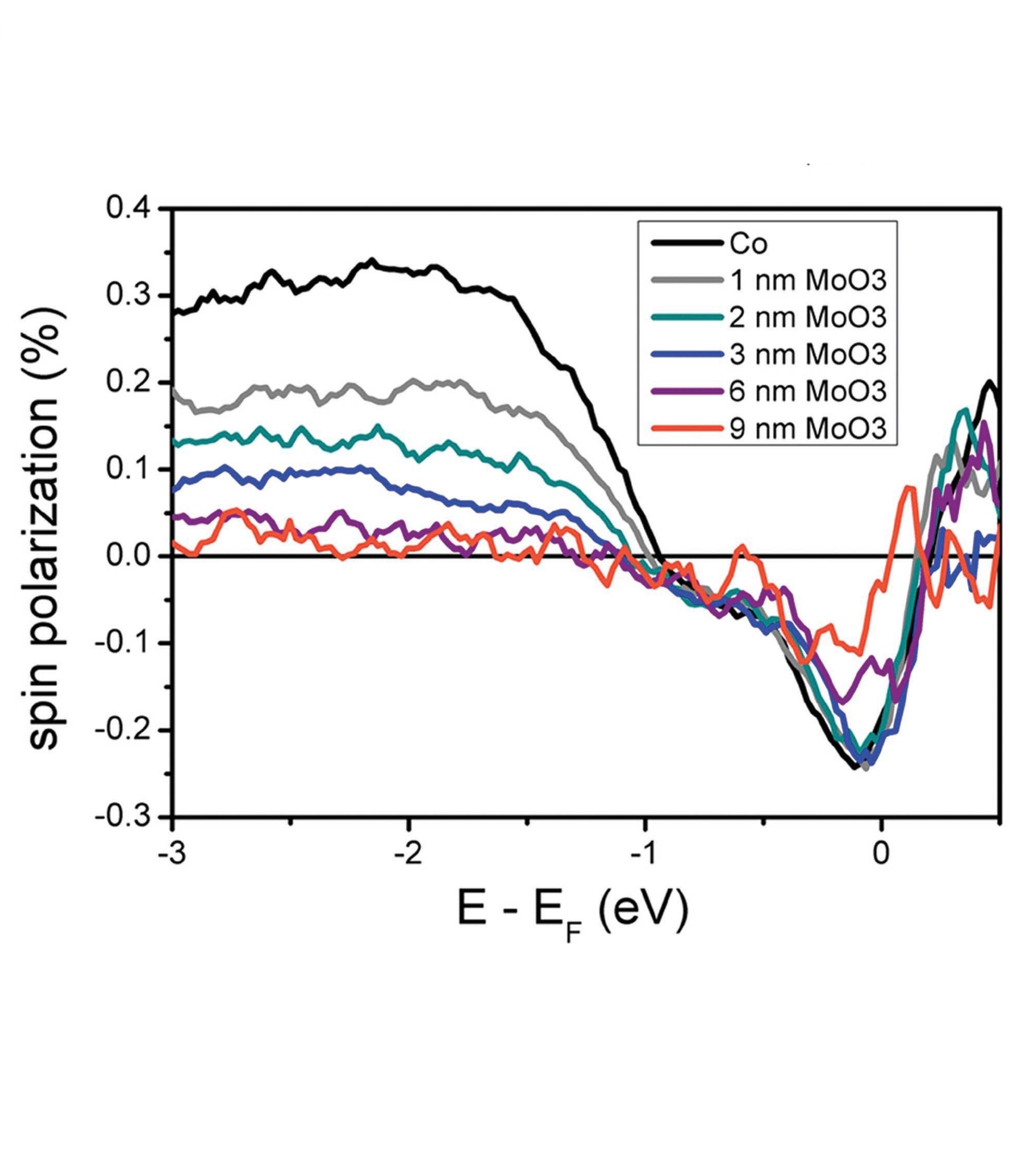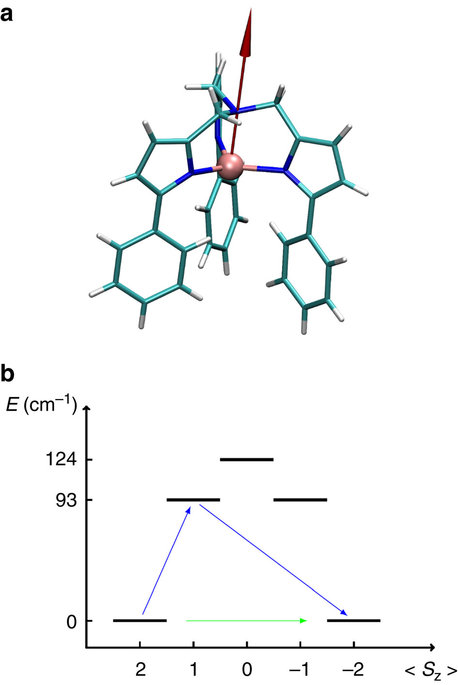| Highlights |
|
J. López-Cabrelles, S. Mañas-Valero, I. J. Vitórica-Yrezábal, P. J. Bereciartua, J. A. Rodríguez-Velamazán, J. C. Waerenborgh, B. J. C. Vieira, D. Davidovikj, P. G. Steeneken, H. S. J. van der Zant, G. Mínguez Espallargas, E. Coronado- Nature Chemistry 2018 Chemical functionalization is a powerful approach to tailor the physical and chemical properties of two-dimensional (2D) materials, increase their processability and stability, tune their functionalities and, even, create new 2D materials. This is typically achieved through post-synthetic functionalization by anchoring molecules on the surface of an exfoliated 2D crystal, but it inevitably alters the long-range structural order of the material. Here we present a pre-synthetic approach that allows the isolation of crystalline, robust and magnetic functionalized monolayers of coordination polymers. A series of five isostructural layered magnetic coordination polymers based on Fe(ii) centres and different benzimidazole derivatives (bearing a Cl, H, CH3, Br or NH2 side group) were first prepared. On mechanical exfoliation, 2D materials are obtained that retain their long-range structural order and exhibit good mechanical and magnetic properties. This combination, together with the possibility to functionalize their surface at will, makes them good candidates to explore magnetism in the 2D limit and to fabricate mechanical resonators for selective gas sensing. |
|
|
A two-qubit molecular architecture for electron-mediated nuclear quantum simulation M. Atzori, A. Chiesa, E. Morra, M. Chiesa, L. Sorace, S. Carretta, R. Sessoli- Chemical Science 2018 A switchable interaction between pairs of highly coherent qubits is a crucial ingredient for the physical realization of quantum information processing. One promising route to enable quantum logic operations involves the use of nuclear spins as protected elementary units of information, qubits. Here we propose a simple way to use fast electronic spin excitations to switch the effective interaction between nuclear spin qubits and the realization of a two-qubit molecular architecture based on highly coherent vanadyl moieties to implement quantum logic operations. Controlled generation of entanglement between qubits is possible here through chemically tuned magnetic coupling between electronic spins, which is clearly evidenced by the splitting of the vanadium(IV) hyperfine lines in the continuous-wave electron paramagnetic resonance spectrum. The system has been further characterized by pulsed electron paramagnetic resonance spectroscopy, evidencing remarkably long coherence times. The experimentally derived spin Hamiltonian parameters have been used to simulate the system dynamics under the sequence of pulses required to implement quantum gates in a realistic description that includes also the harmful effect of decoherence. This demonstrates the possibility of using this molecular complex to implement a control-Z (CZ) gate and simple quantum simulations. Indeed, we also propose a proof-of-principle experiment based on the simulation of the quantum tunneling of the magnetization in a S = 1 spin system. |
|
|
Molecule-based microelectromechanical sensors M. Urdampilleta, C. Ayela, P.-H. Ducrot, D. Rosario-Amorin, A. Mondal, M. Rouzières, P. Dechambenoit, C. Mathonière, F. Mathieu, I. Dufour R. Cléra- Scientific Reports 2018 Incorporating functional molecules into sensor devices is an emerging area in molecular electronics that aims at exploiting the sensitivity of different molecules to their environment and turning it into an electrical signal. Among the emergent and integrated sensors, microelectromechanical systems (MEMS) are promising for their extreme sensitivity to mechanical events. However, to bring new functions to these devices, the functionalization of their surface with molecules is required. Herein, we present original electronic devices made of an organic microelectromechanical resonator functionalized with switchable magnetic molecules. The change of their mechanical properties and geometry induced by the switching of their magnetic state at a molecular level alters the device’s dynamical behavior, resulting in a change of the resonance frequency. We demonstrate that these devices can be operated to sense light or thermal excitation. Moreover, thanks to the collective interaction of the switchable molecules, the device behaves as a non-volatile memory. Our results open up broad prospects of new flexible photo- and thermo-active hybrid devices for molecule-based data storage and sensors. |
|
|
Molecular spin qudits for quantum algorithms E. Moreno-Pineda, C. Godfrin, F. Balestro, W. Wernsdorfer, M. Ruben- Chem. Soc. Rev. 2018 Presently, one of the most ambitious technological goals is the development of devices working under the laws of quantum mechanics. One prominent target is the quantum computer, which would allow the processing of information at quantum level for purposes not achievable with even the most powerful computer resources. The large-scale implementation of quantum information would be a game changer for current technology, because it would allow unprecedented parallelised computation and secure encryption based on the principles of quantum superposition and entanglement. Currently, there are several physical platforms racing to achieve the level of performance required for the quantum hardware to step into the realm of practical quantum information applications. Several materials have been proposed to fulfil this task, ranging from quantum dots, Bose–Einstein condensates, spin impurities, superconducting circuits, molecules, amongst others. Magnetic molecules are among the list of promising building blocks, due to (i) their intrinsic monodispersity, (ii) discrete energy levels (iii) the possibility of chemical quantum state engineering, and (iv) their multilevel characteristics that lead to Qudits, where the dimension of the Hilbert space is d > 2. Herein we review how a molecular nuclear spin qudit, (d = 4), known as TbPc2, gathers all the necessary requirements to perform as a molecular hardware platform with a first generation of molecular devices enabling even quantum algorithm operations. |
|
|
L. Escalera-Moreno, J. J. Baldoví, A. Gaita-Ariño, E. Coronado – Chemical Science 2018 Very recently the closely related fields of molecular spin qubits, single ion magnets and single atom magnets have been shaken by unexpected results. We have witnessed a jump in the phase memory times of spin qubits from a few microseconds to almost a millisecond in a vanadium complex, magnetic hysteresis up to 60 K in a dysprosium-based magnetic molecule and magnetic memory up to 30 K in a holmium atom deposited on a surface. With single-molecule magnets being more than two decades old, this rapid improvement in the physical properties is surprising and its explanation deserves urgent attention. The general assumption of focusing uniquely on the energy barrier is clearly insufficient to model magnetic relaxation. Other factors, such as vibrations that couple to spin states, need to be taken into account. In fact, this coupling is currently recognised to be the key factor that accounts for the slow relaxation of magnetisation at higher temperatures. Herein we will present a critical perspective of the recent advances in molecular nanomagnetism towards the goal of integrating spin–phonon interactions into the current computational methodologies of spin relaxation. This presentation will be placed in the context of the well-known models developed in solid state physics, which, as we will explain, are severely limited for molecular systems. |
|
|
Tuning of a Vertical Spin Valve with a Monolayer of Single Molecule Magnets G. Cucinotta, L. Poggini, A. Pedrini, F. Bertani, N. Cristiani, M. Torelli, P. Graziosi, I. Cimatti, B. Cortigiani, E. Otero, P. Ohresser, P. Sainctavit, A. Dediu, EnriE.co Dalcanale, R. Sessoli, M. Mannini - Advanced Functional Materials 2017 The synthesis and the chemisorption from solution of a terbium bis-phthalocyaninato complex suitable for the functionalization of lanthanum strontium manganite (LSMO) are reported. Two phosphonate groups are introduced in the double decker structure in order to allow the grafting to the ferromagnetic substrate actively used as injection electrode in organic spin valve devices. The covalent bonding of functionalized terbium bis-phthalocyaninato system on LSMO surface preserves its molecular properties at the nanoscale. X-ray photoelectron spectroscopy confirms the integrity of the molecules on the LSMO surface and a small magnetic hysteresis reminiscent of the typical single molecule magnet behavior of this system is detected on surface by X-ray magnetic circular dichroism experiments. The effect of the hybrid magnetic electrode on spin polarized injection is investigated in vertical organic spin valve devices and compared to the behavior of similar spin valves embedding a single diamagnetic layer of alkyl phosphonate molecules analogously chemisorbed on LSMO. Magnetoresistance experiments have evidenced significant alterations of the magneto-transport by the terbium bisphthalocyaninato complex characterized by two distinct temperature regimes, below and above 50 K, respectively. |
|
|
Molecular magnetic hysteresis at 60 kelvin in dysprosocenium Conrad A. P. Goodwin, Fabrizio Ortu, Daniel Reta, Nicholas F. Chilton, David P. Mills – Nature, 2017 Single-molecule magnets have potential data-storage applications, but will need to work at a much higher temperature than has been possible. This study suggests that this goal could be meet in the near future. The authors demonstrate magnetic bistability in a molecule at temperatures as high as 60 K, which is twice that achieved in previous studies. They report a hexa-tert-butyldysprosocenium complex—[Dy(Cpttt)2][B(C6F5)4], with Cpttt = {C5H2tBu3-1,2,4} and tBu = C(CH3)3—which exhibits magnetic hysteresis at temperatures of up to 60 kelvin at a sweep rate of 22 oersted per second. They observe a clear change in the relaxation dynamics at this temperature, which persists in magnetically diluted samples, suggesting that the origin of the hysteresis is the localized metal–ligand vibrational modes that are unique to dysprosocenium. Ab initio calculations of spin dynamics demonstrate that magnetic relaxation at high temperatures is due to local molecular vibrations. For more on this: http://www.nature.com/nature/journal/v548/n7668/full/548400a.html?foxtrotcallback=true |
|
|
Spin Dynamics and Low Energy Vibrations: Insights from Vanadyl-Based Potential Molecular Qubits M. Atzori, L. Tesi, S. Benci, A. Lunghi, R. Righini, A. Taschin, R. Torre, L. Sorace, R. Sessoli - J. Am. Chem. Soc., 2017 Here we report the investigation of the magnetization dynamics of a vanadyl complex with diethyldithiocarbamate (Et2dtc–) ligands, namely [VO(Et2dtc)2] (1), in both solid-state and frozen solution. This showed an anomalous and unprecedentedly observed field dependence of the relaxation time, which was modeled with three contributions to the relaxation mechanism. The temperature dependence of the weight of the two processes dominating at low fields was found to well correlate with the low energy vibrations as determined by THz spectroscopy. This detailed experimental comparative study represents a fundamental step to understand the spin dynamics of potential molecular quantum bits, and enriches the guidelines to design molecule-based systems with enhanced quantum coherence. |
|
|
L. Escalera-Moreno, N. Suaud, A. Gaita-Ariño, E. Coronado - The Journal of Physical Chemistry Letters, 2017 To design molecular spin qubits and nanomagnets operating at high temperatures, there is an urgent need to understand the relationship between vibrations and spin relaxation processes. Herein we develop a simple first-principles methodology to determine the modulation that vibrations exert on spin energy levels. This methodology is applied to [Cu(mnt)2]2– (mnt2– = 1,2-dicyanoethylene-1,2-dithiolate), a highly coherent complex. By theoretically identifying the most relevant vibrational modes, we are able to offer general strategies to chemically design more resilient magnetic molecules, where the energy of the spin states is not coupled to vibrations. |
|
|
Controlling singlet-triplet ratio in OLEDs by spin polarised currents J.P. Prieto-Ruiz, S.G. Miralles, H. Prima-García, A. Riminucci, P. Graziosi, M. Cinchetti, M. Aeschlimann, V. A. Dediu, E. Coronado - arXiv:1612.00633v1 Molecular spintronics has successfully crossed its first decade of life becoming an important player in the race towards the fabrication of next generation spintronic devices. The development and fabrication of spin OLEDs represents one of the key challenges in this area. Indeed, combining spin polarised injection with light emission is expected to establish a quantum control over the statistics of singlet and triplet excitons in the emitting material, enabling a magneto electro optical multifunctionality. This may represent a new route for the increase of light emitting efficiency and, on the other hand, may embody a powerful tool for the investigation of spintronics effects in organic materials. In spite of numerous steps made in this direction, a convincing demonstration of this magnetic quantum control of the light emission has not been accomplished so far. Here, by tailoring the energy level alignment between the frontier orbitals of the organic semiconductor and the electrode work functions, we have prepared a robust spin OLED that shows an increase in the magneto electroluminescence for the antiparallel configuration of the magnetic electrodes, increasing the weight of singlet branch. This result is specially suggestive since for this configuration the total current flowing through the OLED is reduced with respect to that for the parallel configuration due to magnetoresistance effects. Our findings demonstrate that it is possible to inject spin polarised carriers in the frontier electronic orbitals of an organic semiconductor, a question that was still open and debated, beginning the way for a new spintronic control of the OLED emitting efficiency with promising implications in organic. |
|
|
Design of Molecular Spintronics Devices Containing Molybdenum Oxide as Hole Injection Layer. J.P. Prieto-Ruiz, S. Goméz- Miralles, N. Großmann, M. Aeschlimann, M. Cinchetti, H. Prima-García, E. Coronado - Advanced Electronic Materials, 2017. Molybdenum oxide (MoOx)is a very promising material, as it creates an interfacial dipole that increases the metal work function of the electrode. In organic electronic devices, this causes an improvement of the injection of carriers from the metal electrode into the HOMO of the organic semiconductor. However, up to now, MoOx has never been employed in molecular spintronics.
|
|
|
Activating the molecular spinterface M. Cinchetti, V. A. Dediu, L. E. Hueso - Nature Materials, 2017 The miniaturization trend in the semiconductor industry has led to the understanding that interfacial properties are crucial for device behaviour. Spintronics has not been alien to this trend, and phenomena such as preferential spin tunnelling, the spin-to-charge conversion due to the Rashba–Edelstein effect and the spin–momentum locking at the surface of topological insulators have arisen mainly from emergent interfacial properties, rather than the bulk of the constituent materials. In this Perspective we explore inorganic/molecular interfaces by looking closely at both sides of the interface. We describe recent developments and discuss the interface as an ideal platform for creating new spin effects. Finally, we outline possible technologies that can be generated thanks to the unique active tunability of molecular spinterfaces. |
|
|
The role of anharmonic phonons in under-barrier spin relaxation of single molecule magnets A. Lunghi, F. Totti, R. Sessoli, S. Sanvito - Nature Communications, 2017 The use of single molecule magnets in mainstream electronics requires their magnetic moment to be stable over long times. One can achieve such a goal by designing compounds with spin-reversal barriers exceeding room temperature, namely with large uniaxial anisotropies. Such strategy, however, has been defeated by several recent experiments demonstrating under-barrier relaxation at high temperature, a behaviour today unexplained. Here we propose spin–phonon coupling to be responsible for such anomaly. With a combination of electronic structure theory and master equations we show that, in the presence of phonon dissipation, the relevant energy scale for the spin relaxation is given by the lower-lying phonon modes interacting with the local spins. These open a channel for spin reversal at energies lower than that set by the magnetic anisotropy, producing fast underbarrier spin relaxation. Our findings rationalize a significant body of experimental work and suggest a possible strategy for engineering room temperature single molecule magnets. |
|
|
A. Holovchenko, J. Dugay, M. Giménez-Marqués, R. Torres-Cavanillas, E. Coronado, H. S. J. van der Zant - Advanced Materials, 2016 |





